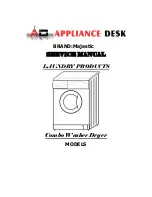
120
ZW-003_v03
WARNING! Do not let any item stick out of the bottom of
the container.
The following cutlery/dishes are:
NOT SUITABLE FOR DISHWASHING
Cutlery with wooden, porcelain or pearl handles.
–
Plastic elements not resistant to higher temperatures.
–
Older cutlery with glued non-heat resistant elements.
–
Glued cutlery or dishes.
–
Tin or copper objects.
–
Lead glass.
–
Steel corrodible objects.
–
Wooden platters.
–
Synthetic fiber objects.
–
PARTIALLY SUITABLE FOR DISHWASHING
Some types of glasses may become opaque after a larger number of washes.
–
Silver and aluminum parts have the tendency to fade due to repeated washes.
–
Glazed patterns may also fade due to repeated dishwashing.
–
ATTENTION! Do not place any items soiled with cigarette ash, candle wax,
varnish or paint. After buying new dishes be sure to check, if they are suitable for
dishwashing.
ATTENTION! Do not overload the dishwasher. Do not use dishes that are not
suitable for the dishwasher. The above recommendations guarantee that the
washing process is effective and energy-saving. Our dishwasher may hold up to
12 tableware sets.
Loading dishes and cutlery
Before loading any dishes into the washer it is advisable to:
scrape off larger amounts of leftovers from the dishes.
●
soften burnt food left on frying pans.
●
All the dishes and cutlery should not block the sprinklers.
●
All hollowed items, such as cups, glasses, pans, etc. should be placed upside down to
●
prevent any water from gathering inside them.
Dishes and cutlery cannot lie in or on top of each other.
●
Glasses should not touch each other in order to avoid any damage.
●
Large items which are hard to clean should be placed on the lower basket.
●
The upper basket should be used for more delicate and fighter dishes, such as
●
glasses, tea and coffee cups.
WARNING! Knives with long blades placed in vertical position are a potential health
threat! Long and/or sharp cutlery, as meat knives should be placed horizontally in
the upper basket.
Damages to glass or other dishes
Possible causes:
Type of glass or its production type.
●
Chemical constitution of a detergent.
●
Water temperature and time of a washing program.
●
Suggested resolutions:
Use glass or porcelain dishes which are marked by their producers as cleanable with
●
dishwashers.
Use mild detergents determining the suitable types of dishes; if necessary contact the
●
producer of the detergent for further reference.
Use low-temperature programs.
●
To prevent any damages pull out any glass objects and cutlery from the dishwasher as
●
soon after a program ends as possible.
Starting the washing program
TABLE OF WASHING CYCLES
Program
Cycle selection Information
Description
Starting/main
detergent
Time span
(min)
Energy
(kWh)
Water
(l)
Shiner
Intensive
For all dishes with stubborn dirt
–such as pots, pans, heat-resistant
dishes and dishes with stuck dried
food.
Initial washing
Initial washing 50°C
Washing 60°C
Rinsing 70°C
Drying
4/20 g
160
1,10
12,9
Normal
(IEC-EN 50242)
Standard daily cycle for normally
soiled loads, such as pots, plates,
glasses.
Initial washing
Initial washing
Washing 50°C
Rinsing 65°C
Drying
4/20 g
155
0,74
12,9
Eco
For dishes with minimal dirt such
as plates, glasses, bowls and pans
without stubborn dirt.
Initial washing
Washing 45°C
Rinsing 60°C
Drying
20 g
105
0,65
10,2
Rinse
For dishes in need of rinsing and
drying.
Washing 45°C
Rinsing 70°C
Drying
95
0,75
7,5
Glass
For glass items with minimal dirt.
Initial washing
Washing 40°C
Rinsing 70°C
Drying
15 g
110
0,75
10,2
Rapid
Short washing for dishes
with minimal dirt without the need
of drying.
Washing 40°C
Rinsing 45°C
15 g
30
0,35
6,5
3in1
For dishes with typical dirt such
as pots, plates, glasses and pans
without stubborn dirt
Standard everyday cycle.
Initial washing
Initial washing
Washing 45°C
Rinsing 70°C
Drying
3in1
160
0,95
14,7
Downloaded from DishWasher-Manual.com Manuals









































